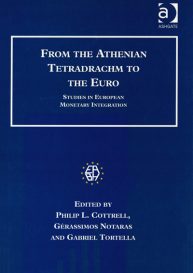From the Athenian Tetradrachm to the Euro
Aldershot. 2007
With the introduction of the Euro much attention was focused on the role of currencies and their national and international significance. Whilst much has been made of the Euro’s achievements in harmonizing Europe’s financial dealings, it is often forgotten that it is by no means the first pan-national currency to enter circulation. Indeed, as the various contributions to this volume make plain, the Euro can in many ways be regarded as a step ‘back to the future’, that is, a further international currency in a long historical tradition that includes the Athenian tetradrachm, the Spanish escudo and the French franc. Covering a timespan of some two and a half millennia, this volume provides a unique perspective, not only to the introduction and development of the Euro, and its predecessors, but also on the broader question of the relationship between trade and common currencies.
Table of contents
- From the Athenian Tetradrachm to the Euro (Theodoros B. Karatzas)
- Common Currency from Antiquity: Plus ça change, plus c’est la même chose(Ioannis Touratsoglou)
- Monetary Integration in the Roman Empire (Juan Carlos Martinez Oliva)
- ‘One Money for an Empire’: Achievements and Limitations of Byzantium’s Currency from Constantine the Great to the Fall of Constantinople (Cécile Morrisson)
- On the History of German Monetary Union (Richard H. Tilly)
- The Latin Monetary Union Revisited Once Again (Marcello de Cecco)
- The Scandinavian Monetary Union 1873-1924 (Lars Jonung)
- The Gold Standard: A View from the Periphery (Pablo Martín-Aceña)
- The Bretton Woods Agreements: A Monetary Theory Perspective (Filippo Cesarano)
- The European Monetary System (Michael Artis)
- European Monetary Union: A Project of Promise and Risk (Paul De Grauwe)
- From the Athenian Tetradrachm to the Euro: Some Concluding Remarks (Vítor Gaspar)
